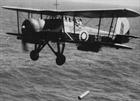On this day 2 May 1945
On this day 2 May 1945 - Telegraphist Air Gunner remembers two ditchings within a month
My name is Robert Lea, I was a Petty Officer flyer – a Telegraphist Air Gunner in the Royal Navy Fleet Air Arm – flying Swordfish in 836 Naval Air Squadron ‘M’ Flight. My role was operating the wireless and manning the rear gun. I joined the Royal Navy age 15 and by the time I was 19, I had ditched twice in the icy waters of the North Atlantic and was lucky to survive. Many of my friends and shipmates didn’t.
836 Squadron was the largest Swordfish Squadron, based in Nova Scotia and Northern Ireland. We were embarked in escort carriers deployed on U-boat operations in the North Atlantic. The Battle of the Atlantic was gruelling and hard. My memory is of a constant sea mist, everything was damp and we were always cold. Flying in open cockpits was freezing. I always wore thick stockings and even then often couldn’t feel my feet in my sea boots.
Taking off and landing on such small flight decks was always very treacherous. I had to face the tail, but I used to swivel round in my position to see if we were going to make it or not! The first time I ditched was on 3 April 1945. We were coming in to land; we caught the hook, but were not quite into wind and the aircraft veered across the deck and slipped over the side. We landed the right way up and scrambled out but there was a heavy swell and after only a few minutes in the water our strength was sapped very quickly. We were picked up by an 800 ton vessel called the Eddystone, she was an inter-island boat, but I didn’t have the strength to climb the rope ladder up the side. My hands were so cold I couldn’t hold on. One of the crew came down the rope ladder and pulled me out of the water.
The second time I ditched was 2 May 1945. We were running very short on fuel and were down to the twelve and a half gallons in the reserve tank. This had to be pumped out of the gravity tank – and the pump had frozen up. We were flying from HMS Campania, an escort carrier and I sent a May Day call as we went in. A second later I heard the carrier call back ‘You’re clear to land’ which was ironic - and awful - as I realised I had not changed the frequency! We landed in the sea the right way up but in the heavy swell, the aircraft sank pretty quickly. My hands were so cold I couldn’t pull the split pin to inflate my Mae West. This time we were picked up by a Royal Navy trawler, HMCS Ironbound. It was so cold that I was unconscious when they pulled me out of the water.
The stress was so great that I did not want to fly again after that. The pilots were incredible young men, very brave and courageous – and so good. I will never forget those pilots. They helped me regain my nerve and got me flying again. The maintainers too, worked in all weathers on the upper deck. They gave their all to get the aircraft serviceable.
The Squadron flew thousands of sorties hunting U-boats. We also shot down two Blohm & Voss 138 flying boats. At the end of the war when we flew into Belfast I remember the officers had their luggage in tins boxes strapped to the Swordfish struts. We were met by Canadian and Dutch sailors who shared their rations with us and took us out for a drink and a run ashore!
Extracts and notes from ‘Fleet Air Arm Aircraft 1939 to 1945’ by Ray Sturtivant with Mick Barrow. Published by Air Britain.
Fairey Swordfish II, HS533, 836 Sqn R Flight.
Caught No1 wire, skidded over starboard side Empire MacKay
3.4.45 Sub Lt J Rodger and L/A R Lea rescued by SS Eddystone
[SS Eddystone was a convoy rescue ship from June 1943. She sailed with 24 convoys and rescued 64 survivors.]
Fairey Swordfish II, NF246, 836 Sqn Dartmouth
Engine Failure during practice anti-submarine bombing, ditched 2.5.45
Sub Lt DCL Griffiths, TAG R Lea & AM1 Baker (died of injuries) picked up by destroyer Ironbound.
[Dartmouth, Nova Scotia was used as a shore base for Swordfish aircraft disembarking from MAC ships][HMCS Ironbound was an anti-submarine Trawler]



